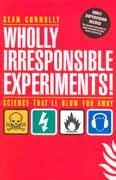Hal Sosabowski reviews this semi-irresponsible experiment guide
Wholly irresponsible experiments!
Sean Connolly
Cambridge: Icon Books 2007 | Pp191 | £9.99 | ISBN 978 1 84 046812 0
Reviewed by Hal Sosabowski

This book presents experiments that budding scientists can try at home, which I welcome and applaud. Although billed as 'wholly irresponsible experiments', many of the experiments are actually quite responsible.
Divided into seven chapters, the book covers demonstrations in chemistry, physics and biology. The chapter titles are slightly cryptic, eg Core concerns, How moving! and Mad science, and to gain an insight into what the theme is in each chapter one has to read the experiment titles. There are 65 demonstrations including the cola/Mentos fountain, the vinegar and bicarbonate of soda volcano and the 'Viking funeral'. However, there is some repetition with the underlying science, ie a concept such as the reaction of vinegar and sodium bicarbonate is covered in three experiments. Each experiment has a 'You will need' section, a detailed method, the 'Scientific excuse' (ie why you would want to do it) and a 'Take care!' (health and safety) section.
I found this an interesting read and as a chemist experienced in doing demonstrations I learned some new experiments. The layout is good and the text is readable. But I'm not sure who this book is aimed at.
Although the narrative style is tailored to children doing the experiments, the author specifies that they must not do the experiments without adult supervision. Of particular concern to me is how health and safety is addressed. To avoid turning off readers to this section the author has used a light-hearted and witty approach, which I like but other potential readers, especially teachers, may find that this dilutes the underlying message. The health warning at the start of the book states that some of the equipment and reagents could be harmful if used incorrectly, but I assert that they could also be harmful if they were used as the book suggests - I cringed at one experiment which involved a mildly caustic reagent and didn't specify eye protection. An alternative approach would have been to provide specified risk assessments.
Adult supervision doesn't necessarily mean expert supervision and there is scope for some mishaps here. In any case users should do their own risk assessments.






No comments yet